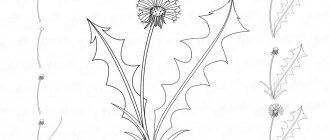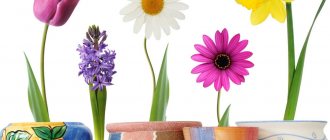- Reports and messages
- Plants
- Dandelion
In spring, when the sun shines brightly and the grass turns green in the fields and meadows, an amazing flower appears - the dandelion.
Although it is considered too simple and ordinary a flower, it is quite unique and interesting. The yellow, fluffy flower decorates forests and meadows with its presence. With its sweet, discreet beauty it pleases not only humans, but also the inhabitants of nature. Dandelion appears too early, when many other flowers have not yet grown. This plays a big role in the life of bees. It is the dandelion that feeds them with its nectar until the main honey plants appear among the clearings. When the time comes for the dandelion to bloom, a white, fluffy cap appears in place of its yellow flower. As soon as the first light breeze blows, the cap takes off and rushes around the area, scattering its seeds everywhere. In those places where the dandelion seeds fell, a new yellow flower will grow next year. Thanks to such frequent flights, the dandelion was able to spread throughout almost the entire territory of the planet. We can say that dandelion is one of the tenacious plants. Many summer residents do not like it and try to get rid of it by all means. Still, dandelion is one of the useful and medicinal plants on Earth. People have found widespread use for this flower. In medicine, various diseases are treated with the help of dandelion. After all, it has many properties. Dandelion stems and leaves are added to the salad. People have learned to make delicious jam from flowers. Dandelion is also used in cosmetology. Moisturizing masks are made from it.
Not only bees love dandelion; butterflies and bumblebees often live on it. Dandelion honey is the thickest, most delicious and aromatic. There are many species of this plant in nature. It can be found in almost every country in the world. Only dandelion does not grow in cold countries. After all, this plant loves warmth and sunlight. Every year, new dandelion flowers will continue to delight us and the animals.
Report Dandelion
Dandelions are small, sunny yellow flowers standing on thin stems. They have a round shape, and if you look closely at them, it seems as if there are many small flowers located inside. Due to their early flowering, they are not the first food for bees. The plant also has healing properties. They make medicine from it, some make salad and even jam from it.
When dandelions fade, ripe fruits appear in their place. They are called achenes. Each of the achenes has a hair on which there is a white fluff, which allows them to be patched in the wind and spread across the ground. Once in the soil, it germinates, resulting in the birth of a new flower. Each dandelion that has bloomed contains a large number of seeds. Perhaps a flower will sprout from everyone in the future. That's why there are a lot of Dandelions on Earth.
A decoction of the roots of this plant stimulates appetite and also helps with digestive problems. Young leaves are used for seasoning, added to soup, and even made into salad. Roasted roots are a coffee substitute. Dandelion coffee is an ideal choice for those who have heart or blood pressure problems.
The whole Dandelion has healing properties. For example, the roots contain natural sugar and starch substitutes. This plant removes toxins from the body and improves mood. It contains various vitamins, as well as a high content of vegetable protein.
Dandelion coffee
To make dandelion coffee you need the root of this plant. Then it needs to be washed thoroughly, cut into large pieces and fried for about 20 minutes or until they turn dark brown.
Dandelion syrup
Dandelions can be used to make cough syrup. To do this you need: 400 dandelion flowers (without root and stem), 1 liter of water, 200 g of sugar and half a teaspoon of citric acid. After putting the plant mass in a container, fill it with water, then drain it, but do not rinse it too much, as the pollen will be washed off, and it is an important health component. Afterwards, you need to fill the flowers again with a liter of water and put them on fire. Then, as the water boils, leave it on low heat for 10 minutes. Finally, you need to add citric acid and cook for 20-25 minutes. The resulting broth should be filtered. Now the flowers are not needed, they should be thoroughly squeezed and thrown away, they have lost all their healing properties. You need to add sugar to the resulting broth, then put it on the fire again. After the water boils, leave to cook for 30-40 minutes. The longer it cooks, the thicker the syrup. The resulting mixture can be poured into jars, and the medicine for cough and sore throat is ready.
Conclusion: The usefulness of dandelions is greatly underestimated due to their ubiquity, but they are one of the important components of many medicines, are included in some culinary recipes and are simply a beautiful flower. Therefore, do not rush to get rid of it if you find it in your garden.
Description for children of 1st, 2nd, 3rd, 5th grade. Field medicinal, surrounding world
Basic concepts and description
Few people know that a perennial plant with a bright color belongs to the Asteraceae family, and it is with this interesting fact that it is worth starting to describe the dandelion. Consisting of many yellow baskets, the dandelion flower tends to close at night or in case of bad weather, opening its face again with the first rays of the sun.
The structural features of the plant, presented in the form of elongated thin hairs capable of moving over impressive distances, can ensure the very rapid spread of the crop. Thanks to this, with the onset of the first truly warm months, yellow flower heads literally dot all lawns and green lawns.
Flower structure
The name of the plant itself comes from the word “to blow,” which is understandable, because at the end of its life cycle it completely changes its appearance, becoming fluffy and weightless, and this fluff can be removed with just one whiff. Other features of the flower:
- Despite its external fragility, the structure of the dandelion is based on a fairly strong branched rhizome, which can go deep into the soil as much as 60 cm, with a cross-sectional diameter of about 2 cm.
- All leaves of the plant are collected in a common rosette, having a smooth plate, and in rare cases, barely noticeable hair.
- Contrary to popular belief, not one, but as many as ten buds can grow from such a flower rosette, although more luxuriantly blooming specimens are also found. The shapes of the bracts of the subcup also tend to vary, which can be broadly ovate, lanceolate, and others, arranged in 2 or even 3 rows. Around the lush yellow inflorescences there is a bell-shaped wrapper, the number of leaves of which varies from 7 to 25. In total, one such basket contains from 20 to 150 reed-type flowers.
- Not only the trunk, but also other parts of the plant have milky sap, which, although not poisonous, can easily provoke an allergic reaction of the skin. Nevertheless, this liquid has much more useful qualities; another thing is that you need to know how to properly use it to treat organs and treat the skin.
After complete ripening, a consistent formation of a fluffy ball of white or grayish tint occurs, consisting of flakes along with seeds, which easily spread over long distances, driven by all the winds.
Spread of culture
The dandelion's range is quite wide , covering almost the entire Eurasian mainland. For example, in Russia, the culture grows almost everywhere, with the exception of the harsh Arctic, limited in the north to Finland, the Arctic Circle and the White Sea. Residents of Western Siberia, except in the highlands, also have the opportunity to watch how a dandelion grows. As for the southern regions, here yellow spring heads tend to appear everywhere except in some lowlands in the Caucasus.
This small wild flower is found along the Caspian Sea, in the Urals and beyond, in Turkmenistan, Afghanistan, Ukraine, Belarus and other surrounding areas. But in the Arctic zones, where there is even very little grass, you can observe other rare flowers, most often endemic, that is, species found only in a specific area.
If we talk about the ideal area for the culture, then its pickiness is a very controversial issue, since dandelions love not only the sun and warmth, but also loose soil with a disrupted growth process of other plants, which is most often found in close proximity to human settlements. And if you don’t interfere with their growth, then in just a few weeks you can get a whole clearing of dandelions right under your house.
But in plowed fields, bright yellow flowers are found in single specimens, mainly concentrated in the wetter and swampy floodplains of rivers. Another thing is forest edges, paths with their green verges, meadows, borders of roadside ditches and other wild nature, where there is complete freedom for dandelions.
Reproduction and medicinal properties
The timing of the beginning of dandelion flowering directly depends on the climatic features and weather conditions in the region where they live. Typically this process starts between April and May, sometimes moving to early June. Despite the fact that the flower is considered a heat-loving plant, its seeds begin to germinate when the soil warms up to 2 degrees Celsius above zero.
However, dandelion propagation occurs not only by seed, because, among other things, the plant is also capable of producing new shoots that originate from dormant buds of the root collar and are activated from the very end of April until the end of summer. The strongest ability to adapt to the surrounding world allows the culture to live in almost any conditions, because it cannot be trampled down or drowned out by some other plants.
Dandelion roots contain a large amount of inulin (up to 40 percent) and other beneficial substances, which is why they are used for medicinal purposes. But in order to obtain truly effective raw materials, it is recommended not to collect rhizomes in the summer, since the plant spends a lot of energy on flowering. But spring and autumn, which marks the end of the plant’s fruit formation, are perfect for collecting and preparing.
Usually the whole procedure boils down to removing the remaining soil and dirt from the roots, rinsing them in clean cool water and drying them without direct sunlight for several days. The healing juice of dandelions, which has the property of being called milky, is also very popular. To prepare it, not only the short and long stems of the plant are used, but also its leaves, which are lightly squeezed and soaked in clean salted water to neutralize the bitterness.
The resulting raw materials are consumed in pure form or prepared together with alcohol in a ratio of 1 to 1. Also, all kinds of healing decoctions and infusions are prepared from the milky juice. As for the medicinal properties of the plant, there are a lot of them, but most often dandelions in various forms help in the following cases:
- A decoction of the dried root promotes digestive secretion, having a powerful choleretic effect, which has the best effect on liver function.
- Root tincture significantly improves appetite, and also gives a powerful laxative and antispasmodic effect. It is known that its regular use helps cleanse the blood (we are talking about moderate doses).
- Dandelion tincture is indicated for vitamin deficiency, which is especially acute in the spring, since the plant is rich in carotenoids and B2 vitamins.
- It is used to prevent atherosclerosis and as a powerful antioxidant.
- To enhance the effect, dandelion juice is mixed with carrot juice and used for cholecystitis.
- The plant extract has been proven to have antitumor properties.
- Diuretic and laxative properties make it possible to use dandelion-based medicines to relieve swelling and for weight loss.
- Highly effective in treating anemia.
- It is used in the complex treatment of acute respiratory infections as an expectorant and antipyretic.
- The juice, when diluted, can be used to treat eczema and furunculosis.
Unfortunately, there are some contraindications, because any products prepared with dandelions are not recommended for use in the presence of peptic ulcers and gastritis. In addition, its use is prohibited in case of blockage of the bile ducts.
Popular message topics
- The Great Wall of China
The Great Wall of China is a modern wonder of the world. It was built over a period of more than 2,700 years and its length is more than 8,850 km. The height of the wall reaches 9 m in some areas, and the width is 6.5 m. The main function of its creation was protection - Jumping
All these types of jumping belong to the discipline of athletics. Which they begin to teach in general educational institutions, and in special children’s circles, if you study hard and train, you can become a famous Olympic athlete - Fairy tales of Pushkin
Almost all of us are familiar with the work of the famous Russian writer of the 19th century, Alexander Sergeevich Pushkin. It was this creative figure who was the creator of the Russian literary language. But few people know
Beautiful poems about dandelions
Dandelion in the grass. White night is unearthly, I can’t tear myself away, growing into my hand... And I forgive myself - I didn’t stay. Happens. And I forgive you: holding on is not easy... All steps are in unison. For two we love everything: Gateways. Bridges. Expectations. Dreams. At the end of spring, those passing by - How we were alone. How pure we were. Don’t separate – finally – the intertwined fingers... The dandelion juice on the palms is not washed away. If the memory is alive, don’t try to kill: We wandered through the parks and sang our hearts out, We fed your diet bun to the fur cohort of ducklings on the Neva. I forgive my Peter for all the nooks and crannies, For the fragment of love - a dandelion in the grass...
≈≈≈≈≈≈≈≈≈≈≈≈≈≈≈≈≈≈≈
The dandelion woke up easily, and dewdrops fell into the eyelashes. With a yellow face, he looked out the blue enamel window of the Firmament.
Oh, how sunny it is there, at dawn, my friend Dandelion burst open! He served all night on the other side to make the world smile.
Dandelions' eyes met, They waved their rays at each other... The dewdrop outfit sparkled, And the poet responded with poetry.
≈≈≈≈≈≈≈≈≈≈≈≈≈≈≈≈≈≈≈
Furry dandelions were scattered across the fields. Yellow-colored, clumsy decoration for poems.
They smell like thick, drunken honey... it makes you feel dizzy! Nature is waking up, full of spicy smells.
My dear friend, dandelion! I will weave you into a wreath. I just know that you are a deceiver - you will turn gray in the morning...
≈≈≈≈≈≈≈≈≈≈≈≈≈≈≈≈≈≈≈
Olga Volkova
Dandelions are like midgets, With funny yellowness in their heads; I love these little suns, Drops of light in the spring grass.
Where the freeway is always noisy, Where the engine never tires of roaring, Suddenly they gathered together like chickens to look at the spring sun.
The golden heads will not last long - They, the old men, will turn grey; And then their pubescent wigs will fly over the road.
≈≈≈≈≈≈≈≈≈≈≈≈≈≈≈≈≈≈≈
In the meadow, on a thin stem, a yellow dandelion was born. Among the flowers on a small river He hid in small blades of grass.
The dandelion grew, the meadow blossomed, He had a big dream - He wanted to see the world around, To see the Earth without end and edge.
A boy once ran across the field and picked a dandelion with his hand. He blew and scattered the dandelion. Dandelion met a dream.
≈≈≈≈≈≈≈≈≈≈≈≈≈≈≈≈≈≈≈
He came with the ruddy dawn, a mischievous cheerful dandelion, to a sun-drenched meadow,
And, smoothing the yellow sundress, he started a round dance with chamomile and shy porridge...
And then, and then Over the abandoned pond Soared like a white moth:
Like a ping pong shuttlecock, a dandelion has flown around in the currents of air: it takes off, then lands.
≈≈≈≈≈≈≈≈≈≈≈≈≈≈≈≈≈≈≈
Natalie SAMONIY
The years are dandelions, gray hair is their trace: The girl is already a grandmother, and the boy is a grandfather.
The years are like dandelions, flying away. A boy or a girl is a son or a daughter.
The dandelion years fly by by the hour. They are plucked by fingers that want warmth...
Years are dandelions, time is a tomboy. Ruined youth is not the end.
The dandelion years are a faded color, Children are the light of endless, eternal life.
... Life will grow the torn youth again: We will live forever in children, grandchildren, great-grandchildren!
≈≈≈≈≈≈≈≈≈≈≈≈≈≈≈≈≈≈≈
Natalie SAMONIY - The last dandelion of spring...
The last DANDELION says goodbye to spring. And summer, like a nimble boy, departs from sleep, plays pranks with its fluffs, blowing them into fireworks... The days of spring sing with farewell tears.
Spring says goodbye with a joyless smile - The rains make summer more rosy, she visited... The last dandelion suddenly took flight - Alas, it’s no longer tempting... It’s time to leave for a year.
≈≈≈≈≈≈≈≈≈≈≈≈≈≈≈≈≈≈≈
Natalie SAMONIY – Dandelion Spring
Dandelion, a sunny flower, Smiles with a honey smile - Once again spring has stepped on the threshold With colorful flowers, a holiday card.
I scattered the gold coins of the dandelions on their cheerful faces, in their eyes the light of happiness flows... Dandelions are spring cuties!








